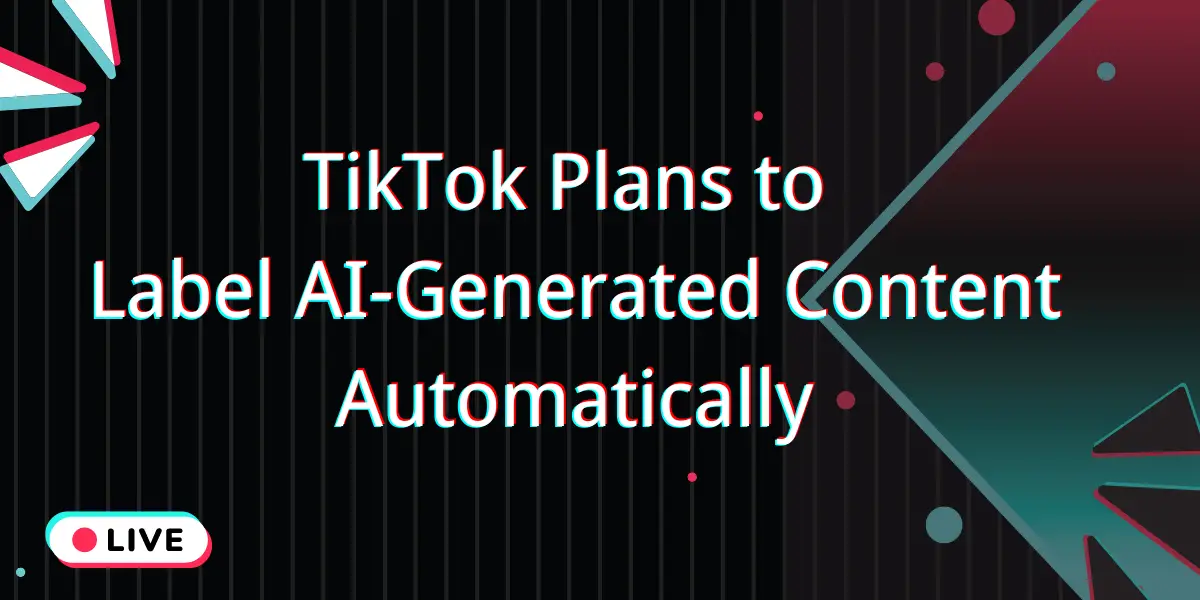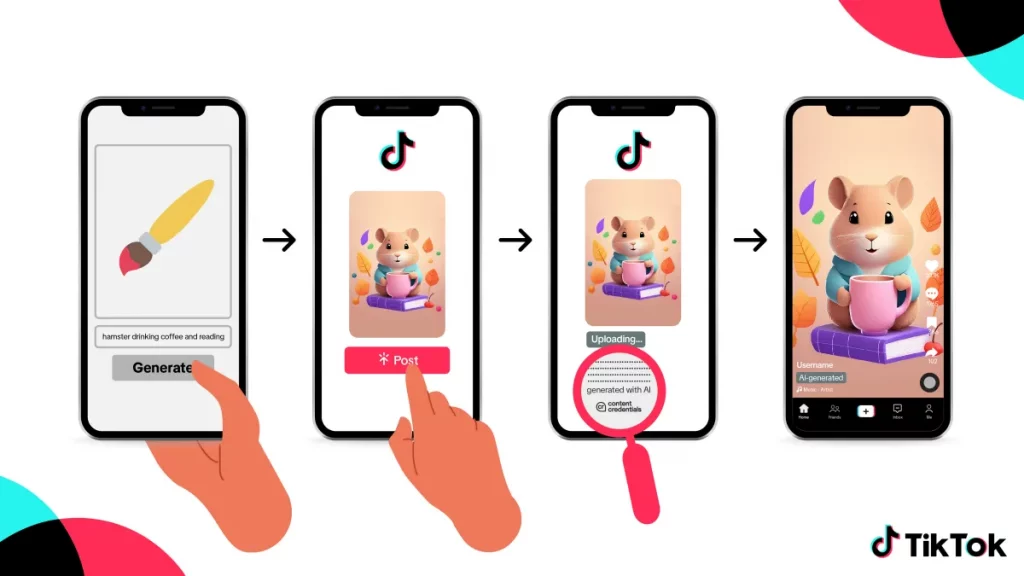TikTok Plans to Label AI-Generated Content Automatically

TikTok’s recent introduction of automatic AI labels marks a significant milestone in digital content transparency. This proactive move aims to enhance users’ understanding of content origins, fostering an environment of trust and clarity on the platform.
TikTok introduces automatic AI labels to enhance transparency and user trust, setting industry standards for AI content disclosure.
Table of Contents
Why does TikTok launch automatic AI labels?

TikTok’s decision to implement automatic AI labels stems from a multifaceted strategy aimed at enhancing user experience and trust. The introduction of these labels is not merely a compliance measure but a proactive step towards greater transparency in the digital space. Here are the key reasons behind this initiative:
- Enhancing Transparency: Ensuring that users can easily distinguish between AI-generated and human-created content.
- Building Trust: Strengthening user trust by clearly marking content that has been altered by AI, thus preventing any potential misinformation.
- Regulatory Compliance: Meeting the increasing global regulatory demands for clearer disclosure of AI involvement in content creation.
- Promoting Responsible Use of AI: Encouraging ethical use of artificial intelligence technologies among creators.
Other platforms' attitude toward AI labels
While TikTok leads with its automatic AI labeling initiative, other major platforms have adopted varied stances on this issue, reflecting a broader spectrum of approaches to AI-generated content across the digital media landscape.
YouTube
YouTube has been increasingly vigilant in its approach to AI-generated content, focusing on transparency and misinformation prevention. The platform has implemented policies requiring clear disclosure of AI-generated content in videos, especially when such content could mislead users about factual matters or news. YouTube’s approach is less automated than TikTok’s, relying more on creators’ compliance and viewer reporting to manage the vast amount of content uploaded daily.
Instagram, another major player in the social media sphere, has yet to implement a formal, platform-wide policy for labeling AI-generated content. Instead, the platform encourages creators to self-disclose when they use AI tools to alter images or videos significantly. Instagram’s policy focuses more on user education and awareness, promoting transparency through community guidelines that suggest best practices rather than enforce strict rules.
Facebook has taken steps to address AI-generated content by enhancing its fact-checking capabilities and partnering with third-party organizations to identify misleading AI-created materials. Like Instagram, Facebook relies heavily on user reports and AI to flag potential misinformation, but it does not yet have a dedicated labeling system for AI-generated content. The platform’s strategy emphasizes preventing the spread of misinformation rather than explicitly labeling AI-generated content.
How does TikTok detect AI-generated content?

TikTok employs a combination of technological and manual review processes to detect and label AI-generated content. This approach allows the platform to maintain accuracy while adapting to the rapidly evolving nature of AI technologies.
Technological Detection
TikTok’s system uses advanced machine learning algorithms trained to identify AI-generated content. These algorithms analyze various elements of content, such as textures, patterns, and inconsistencies that typically differ in AI-generated media compared to human-made creations.
User and Creator Inputs
In addition to technological measures, TikTok leverages reports from its user base and inputs from content creators to identify AI-generated content. This community-driven approach helps cover gaps that automated systems might miss, ensuring broader oversight.
Continuous Improvement
The detection algorithms are continuously updated based on new data and evolving AI creation methods. This iterative process helps TikTok keep up with the latest developments in AI technology, ensuring the platform can effectively identify new forms of AI-generated content.
How does TikTok’s AI label align with global AI standards
TikTok’s approach to AI labeling is designed to align with emerging global standards on AI transparency and ethics. The platform’s efforts are part of a broader industry movement towards more responsible AI usage.
Adherence to Regulatory Standards
TikTok’s labeling practices comply with international regulations, such as the EU’s AI Act, which mandates clear labeling of AI-generated content to ensure user transparency and trust.
Collaboration with Ethical Bodies
TikTok collaborates with global ethical bodies and follows guidelines set by AI ethics groups to ensure its labeling practices meet the highest ethical standards. These collaborations help shape policies that are both effective and ethically sound.
Educational Initiatives
Beyond compliance, TikTok invests in educational programs to inform both creators and users about the nature of AI-generated content. These initiatives are crucial for building an informed user base that can critically engage with AI-labeled content.
How will the TikTok AI label influence content creation?

TikTok’s introduction of AI labels is poised to significantly influence the landscape of content creation on the platform. By making the use of AI transparent, TikTok is setting new standards that creators must adapt to.
- Encourages Ethical Use of AI: Creators are prompted to consider the ethical implications of their use of AI, fostering a culture of responsible AI usage.
- Spurs Innovation: With clear labeling, creators might explore more innovative AI applications in content creation, knowing that the audience is informed.
- Promotes Authenticity: Creators may choose to highlight human-driven content to differentiate themselves, enhancing the authenticity of their offerings.
- Influences Audience Engagement: Knowing content is AI-generated might affect how audiences engage with it, potentially changing how creators approach content design.
The impact of TikTok AI label on viewer experience
The AI labeling initiative by TikTok is set to transform how viewers interact with content, enhancing their overall platform experience.
- Enhanced Trust and Transparency: Viewers can trust the content more as they are clearly informed about what is AI-generated.
- Informed Viewing Choices: With labels, viewers can make more informed decisions about what they choose to watch or skip.
- Educational Value: The labels serve as educational tools that help viewers understand the extent of AI’s role in content creation.
- Content Filtering: Viewers could potentially filter content based on AI involvement, tailoring their feeds to prefer either AI-enhanced or purely human-created content.
What feedback has TikTok AI label received?
Since its implementation, TikTok’s AI labeling initiative has garnered varied feedback from different stakeholders within the platform ecosystem.
- Positive Reception from Advocacy Groups: Digital rights and transparency advocates have praised the move for fostering greater honesty in digital content.
- Mixed Reactions from Creators: Some creators appreciate the transparency, while others express concerns about possible negative perceptions of AI-generated content.
- Viewer Curiosity and Approval: Viewers have shown curiosity about AI capabilities and generally appreciate the transparency, which helps them understand the content better.
- Regulatory Approval: Government and regulatory bodies view this as a positive step towards compliance with emerging digital media standards.
The challenges of implementing AI label on TikTok
Implementing AI labels on TikTok presents several challenges that the platform must navigate to ensure the initiative’s success.
Technological Challenges
Accurately detecting and labeling AI-generated content requires sophisticated algorithms that can keep pace with rapidly evolving AI technologies. This ongoing development demands significant investment in technology and expertise.
User Acceptance
Getting creators and users to adopt and appreciate the labeling system is a challenge. Educating them about the importance and implications of AI labels requires consistent outreach and engagement efforts.
Balancing Innovation and Transparency
TikTok needs to balance the encouragement of creative AI use with the necessity for transparency. This involves ensuring that labels do not stigmatize AI tool use or stifle creativity.
Future and development plan of TikTok label
Looking ahead, TikTok plans to continuously refine its AI labeling system to enhance accuracy and user-friendliness. The platform intends to expand its educational initiatives to ensure users and creators fully understand the implications and benefits of AI labels. Additionally, TikTok aims to collaborate more extensively with tech developers, policymakers, and global regulatory bodies to stay ahead of industry standards and ensure that its labeling practices are robust and internationally compliant.
Conclusion
TikTok’s initiative to label AI-generated content marks a significant step in the platform’s evolution, reflecting a broader commitment to transparency and ethical standards in digital media. As this initiative unfolds, it will likely shape not just how content is created and consumed on TikTok, but also set a precedent that could influence the wider industry. This move not only aligns with global regulatory trends but also enhances the integrity of the digital ecosystem, making TikTok a pioneering force in responsible AI usage.

